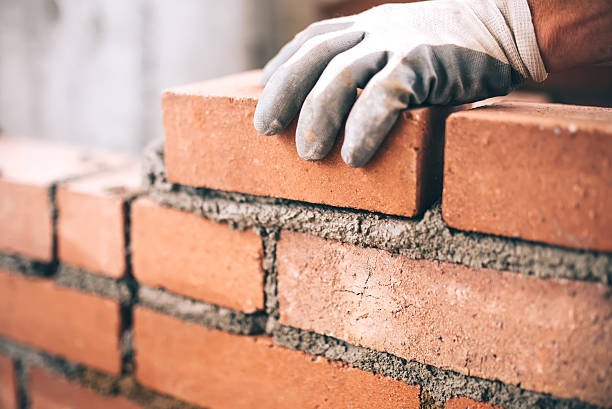Opening the Secrets of Sustainable Stonework Construction Practices for Eco-Friendly Buildings
Amongst the myriad techniques to green structure, lasting masonry construction stands out as a time-tested and sturdy approach that holds a riches of untapped potential. From the option of materials to innovative construction strategies, the tricks to achieving sustainability within stonework building and construction are diverse and appealing.
Advantages of Sustainable Masonry Building And Construction
Embracing sustainable masonry construction methods not just reduces environmental effect yet also provides lasting economic advantages to building contractors and areas. By making use of products like recycled bricks, blocks, and stones, contractors can substantially decrease the carbon footprint of their jobs while advertising source performance. In addition, lasting stonework construction methods, such as appropriate insulation and thermal mass residential or commercial properties, can enhance energy effectiveness within buildings, resulting in minimized operational costs in time.
Furthermore, the toughness and strength of stonework frameworks add to long-lasting economic advantages. Buildings constructed using sustainable stonework techniques often call for much less repair and maintenance, converting to set you back savings for home builders and homeowner. The long life of stonework products likewise guarantees that structures remain stable and safe and secure, lowering the demand for regular remodellings or substitutes.
Eco-Friendly Stonework Materials
Using environmentally friendly masonry products is an essential step in the direction of enhancing the sustainability of building and construction methods and minimizing environmental influence while making best use of long-lasting financial benefits. Lasting masonry products are sourced, created, and utilized in a way that decreases total environmental influence. Materials such as recycled blocks, recovered rock, and sustainable cinder block are ending up being significantly prominent options for eco-conscious home builders. Recycled bricks, for instance, not only draw away waste from landfills yet likewise call for much less energy to generate compared to brand-new bricks. Redeemed rock supplies an one-of-a-kind aesthetic allure while decreasing the demand for new quarrying. Sustainable concrete obstructs incorporate recycled aggregates and might feature enhanced insulation properties, adding to power efficiency in buildings.
Furthermore, natural materials like adobe, rammed earth, and straw bales offer exceptional thermal mass properties, reducing the need for heating and cooling energy. These products are often locally available, promoting regional economies and decreasing transportation-related carbon discharges. By selecting environment-friendly masonry materials, construction tasks can significantly reduce their ecological impact and add to the development of healthier, more lasting built environments.
Energy-Efficient Stonework Strategies
Energy effectiveness plays a vital role in enhancing the sustainability of stonework building techniques. One crucial energy-efficient stonework method is the usage of thermal mass, which involves integrating thick products like concrete or brick right into the building's structure to soak up and store warm.

Developments in Sustainable Masonry
Recent advancements in lasting stonework techniques have actually caused cutting-edge strategies that are improving the building and construction market. One such advancement is the advancement of self-healing concrete, which uses bacteria embedded within the concrete to recover fractures autonomously. This advancement not only reduces upkeep prices however likewise enhances the sturdiness of masonry structures, adding to their sustainability.
An additional remarkable development is using recycled accumulations in stonework building and construction - masonry contractor. By integrating products such as smashed ceramic waste or recycled glass right into concrete mixes, contractors can reduce the ecological effect of construction tasks while maintaining architectural stability. This practice not just diverts waste from land fills yet likewise preserves natural deposits, making it a key innovation in sustainable stonework construction
In addition, the combination of electronic design devices, such as Structure Info Modeling (BIM), is transforming the means masonry frameworks are planned and created. BIM enables even more precise computations, decreased product wastage, and improved energy efficiency, eventually leading to more lasting building practices. These advancements collectively represent an encouraging future for sustainable stonework building and construction in the age of green structures.
Future Trends in Masonry Sustainability
With the ingenious strides made in lasting stonework practices, Home Page the future patterns in stonework sustainability are positioned to further transform the building sector. Among the vital patterns forming the future of stonework sustainability is the increased integration of innovation. Innovations such as Structure Details Modeling (BIM) and digital reality simulations are being utilized to optimize masonry building procedures, bring about lowered material waste and improved power performance in structures.
Furthermore, the development of novel sustainable products is readied to play a significant role in enhancing the eco-friendliness of masonry building. masonry contractor. Advancements like self-healing concrete, recycled accumulations, and bio-based binders are getting grip for their capability to lessen ecological effect while preserving architectural stability

Verdict
In verdict, sustainable stonework building methods use various advantages for green buildings. By making use of environment-friendly materials and energy-efficient methods, masonry can add to an extra sustainable constructed environment. Innovations in sustainable stonework are continuously being created to even more boost the environmental performance of structures. Looking towards the future, the pattern of stonework sustainability is expected to expand, resulting in even more eco-friendly and energy-efficient building and construction practices in the years to find.